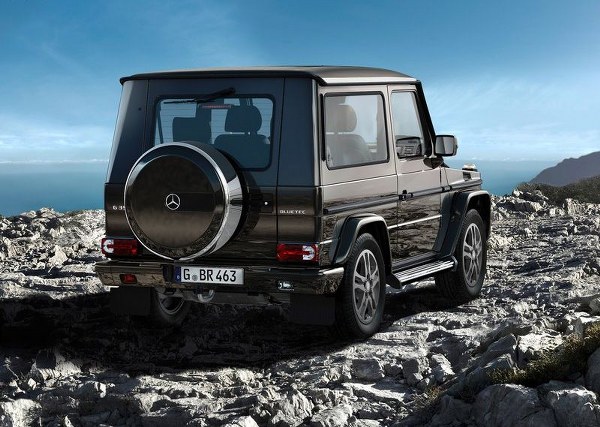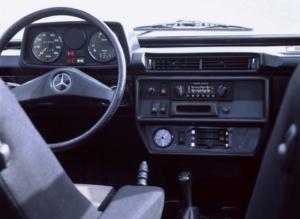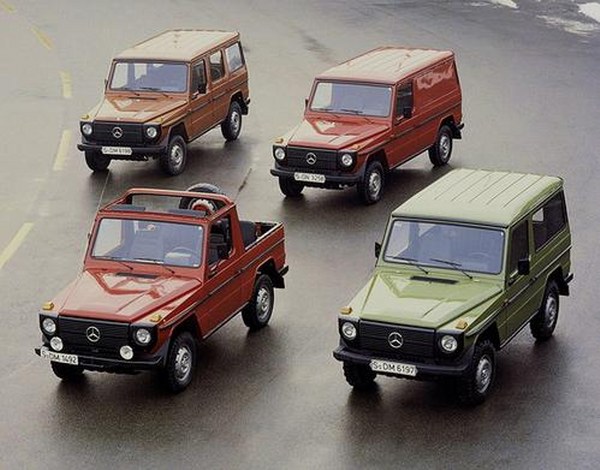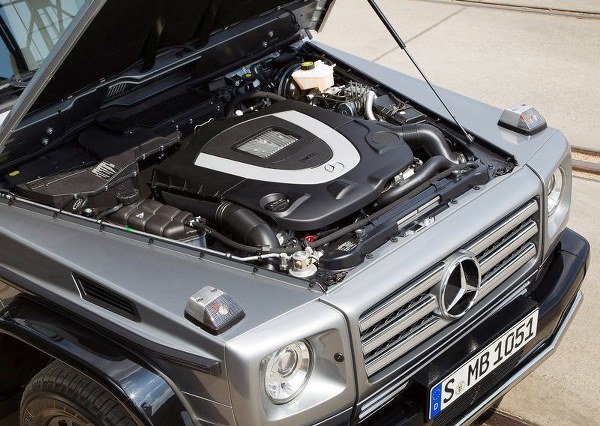Mercedes G class (1979 -) - Used car, experiences, problems

Mercedes G Class
Few vehicles boast long production like the Mercedes-Benz G that appeared back in 1979, although it has survived several significant upgrades, and still retains its original angular shapes with straight side walls and flat windows. The origin of the letter G, the letter G is the first letter of the German word Geländewagen, i.e. Off-road vehicle.
In addition to Mercedes, the Austrian company Steyr-Puch was also involved in vehicle development, Steyr-Puch had extensive experience in the production of 4 × 4 vehicles.

Mercedes G Class
It must be added that Mercedes The G-Class was also sold under other brands, namely Puch sold the G-Class under its own name in Austria and neighboring Switzerland and under the Peugeot P4 brand. However, the French manufacturer delivered the vehicle with its engines and gearboxes, and the rest remained in the original version.
Mercedes-Benz G Class is used by armies and security forces around the world, including our military. With us in the military, you can meet the Mercedes G class under the brand Puch.

The vehicle had to be useful for the military, so it had to be universal in its own way. A decent frame, a solid suspension that is great for off-road driving on different terrains and a body whose every part except the headlights and the Mercedes badge looks like it was designed only with the help of squares. As if that wasn't enough, the car was sold in several wheelbases and different body configurations, creating up to 14 different combinations together.
The Mercedes G Class designed as the W460 was built for 11 years until 1990.
Over time, the Germans noticed that the G-Class could be used not only in the army, in the field or in extreme conditions, but after adding a few devices, the car could be indestructible, but at the same time a practical and luxurious roadster. This is how the W463 model was born in 1990. Mercedes, however, has not forgotten about fans of off-road driving, and especially for them version W461, a continuation of the development of the older model.
The new versions already have a permanent four-wheel drive, which was only introduced in 1989. The earlier W460 lacked a center differential.
Four years after the production of the W463 began, Mercedes has decided to officially change its name. Since then, all Gelands have been called the Mercedes G-Class. In addition to the aforementioned permanent two-wheel drive, the new G-Classes were much better equipped than their predecessors. Power windows, air conditioning, leather upholstery, automatic transmission, in short, equipment that wouldn't be ashamed of a decent sedan in the XNUMXs.

Mercedes G Class
Serious changes have also taken place under the hood. Previously offered petrol and diesel engines had one basic task - to get the car out of the worst of oppression and accelerate the square body to a speed that allows driving on expressways or highways. However, in 1998, the G500 version with a 5.5-liter V8 engine entered the market. 296 hp accelerated the car to the top 9,7 in 190 seconds and guaranteed a top speed of 20 km / h. Very decent performance for a real roadster. However, he consumed 354 liters in the city. However, a year later, the car fell into the hands of tuners from AMG. 525 hp and 7,4 Nm of torque provided the first hundred km / h in just 210 seconds and a top speed of XNUMX km / h.
The chassis is traditionally independent of the body on all versions and rigid axles, springs. Asphalt driving therefore cannot be compared to conventional SUVs with independent wheel suspension.
For more agile driving, the G-Class tilts significantly thanks to its high body, so it's not for narrow and winding roads. Similarly, with ride comfort, which is especially important for off-road versions. The W463 is a little better for driving comfort, though the G-Class is still an all-terrain vehicle rather than an asphalt vehicle.
When the car leaves a solid ground, then it shows what it really is. The climbing ability of the vehicle is 80%, the side inclination is 54%, the ramp - 36 ° in front and 27 ° in the back, the ground clearance is 210 mm.
Of course, there is a reduction gearbox and the ability to lock three differentials with three buttons. When locking the differentials, of course, there is limited control, which signals the illuminated triangle on the instrument panel.
Off-road driving is facilitated by the view from the vehicle, given the greater visibility and flat side windows. Interestingly, the G-Class has the option to turn off the ABS until 1997.
Engines - Mercedes G class

Mercedes G Class
Gasoline engines
Under the G-Class hood, a fairly large amount of engine has been replaced over time. In the case of the first years of production, forget about some dynamic driving, especially in the case of atmospheric diesels.
What dynamics, slightly spiced with a top speed of 155 km / h, allowed only a six-cylinder 280 GE. But watch your consumption. Even smaller units are not economical, but 280 GE, especially in the city, charges for its services with consumption of more than 20 liters.
With the modernization, the power-to-fuel ratio of petrol engines has gradually improved and a six-cylinder G320 (M120) with 158 kW power output could be a good choice. The engine provides good driving dynamics for normal driving, but it boasts less than 12-13 liters.
Very good dynamics are offered by the G 500 versions or the sharper AMG. Very good dynamics is accompanied by adequate - high consumption, but also with high costs of regular service.
Diesel engines
Especially due to more favorable consumption, there is a much greater interest in diesel G class. Although the old atmospheric engines did not offer driving dynamics, but in terms of reliability, they were almost indestructible.
Special mention is made of the G300 Diesel series with six-cylinder engines of 83 kW and a torque of 185 Nm. "With a little care, this engine can last for millions of kilometers. Modification of this engine is achieved by installing a turbocharger, which gives you driving dynamics, but beware of non-professional modifications that can have a significant impact on the life of the engine.
The G250 Diesel version with 69 kW power output is also known for its good reliability. However, the dynamics are really poor, even when there is only one person in the vehicle.
Much more dynamic than the G300 Diesel is the newer G350 Turbodiesel with 100 kW power and 305 Nm of torque. Compared to the older version, however, the durability of the engine reliability has slightly deteriorated, especially when the vehicle is handled roughly.
More mechanical resistance was given to the successor to the G300 Turbodiesel with a power of 130 kW and torque of 330 Nm. Unlike its predecessor, it uses 4-valve technology and an electrically controlled in-line pump. The engine offers good dynamics, but consumption goes over 10 liters.
Common Rail was the first to introduce the five-cylinder G270 CDI turbo engine with 115 kW and 370 Nm of torque. The engine delivers a rugged G class with decent dynamics at an acceptable consumption of about 10 liters. The engine is reliable, problems usually occur after high mileage.
For more demanding drivers, we offer diesel in the form of an 8-cylinder G400 CDI with an output of 184 kW and a torque of 560 Nm. The engine pushes the G-Class well, regardless of the number of passengers, the weight of the load and the terrain. In this case, it is not about consumption (about 14-15 liters on average), but about financially demanding service and especially very problematic reliability.
Both units were gradually replaced with one three-liter six-cylinder, which was produced in several engine versions. The G280 CDI, G320 CDI and G350 CDI (BlueTec) always have an engine capacity of 2987 cc and a power range of 135 kW over 155 kW to 165 kW (400 Nm - 540 Nm). Extreme performance for normal driving is provided by even the weakest version, which makes it stronger when driving fast. Consumption is also at a good level, which with a little luck can amount to about 10 liters. Due to the complexity, the reliability is also at a good level, especially the version without DPF filters.
Reliability and failures
Mercedes The G is a very robust and, with some exceptions and reliable engines, a vehicle that has served faithfully for decades. Of course, with regular and quality service.
In older models, corrosion of the body and chassis is common. Newer models are better protected against corrosion, sensitive areas are the lower edge of the windshield, fender, lower doors, sills and chassis parts. Corrosion is also affected by improperly repaired body parts, so be sure to check your current condition. Older models also have to check the windshield, occasionally water may enter the windshield cedar.
Frequent rough terrain rides damage the body and powertrain. Buying a halfway house requires a proper visual check. It is necessary to focus on the various damage and oil leaks, most commonly from the rear axle, of fat from the anterior homokinetic joints.
Higher noise levels are also due to excessively worn mechanical transmissions. Older automatic transmissions are not uncommon for oil leaks; the newer 7G-Tronic automatic transmissions have a problem with the control unit. It is advisable to change gearbox oil every 60.000 km, which is useful for the life of complicated mechatronics as well as the converter itself.
Gasoline engines are characterized by good reliability, only the G 320 and G 500 (M272 and 273) are problematic.
In the case of the 350 TD, the cylinder head sometimes breaks, rarely the engine block. This applies in particular to engine overload or full throttle (cold engine) or cooling failure - fluid leak or inactive fan coupling. With more used pieces, it is possible to encounter excessive mechanical wear of the engine, which is reflected in increased oil consumption and difficult cold start.
The injection pump breakdowns occur with the 300 TD, which is not a cheap thing because the solution is a costly repair in a specialist service.
320 CDI and 350 CDI - Sometimes the engine heater relay does not start and the vehicle will not start. And with higher mileage, the risk of servomotor failure increases the intake channel control mechanism.
Excessively spent or damaged turbochargers are mainly due to small waste from the exhaust. Excessively worn turbocharger reveals higher engine oil consumption, oil enters the intake, greater fatigue, turbine whistling and weaker engine power.
Six-cylinder CDI diesels that comply with the Euro 4 exhaust emission standard, more frequent shorter rides damage the DPF filter - if it is equipped with an engine. In addition to increasing the average consumption by 1-2 liters (compared to the version without DPF), it is even more sensitive to driving. In the case of Euro 5 engines that contain DPF as standard, the difficulty with a clogged filter is significantly less, and also the average consumption is slightly lower.
The most problematic is the 400 CDI eight cylinder. The list of problems affecting this engine is large. Most commonly, there are problems with the propulsion mechanism, injectors, excessive turbocharger wear and engine wear.
For diesel engines, especially with Common rail injectors, the problem of injector wear is manifested by gross uneven engine operation, heavier cold starts or lower engine power and higher power consumption.
Service
Engine oil is changed every 10.000 km in older diesel engines. For petrol and diesel CDI engines, the interval is every 15.000 km or 1 year. However, even with CDI engines, it is recommended to reduce the interval by 10.000 km in case of more demanding operating conditions. Every 60.000 km, the oil in the automatic transmission changes.
All engines have a maintenance-free drive chain that requires replacement only if necessary (excessive wear). Checking every 60.000 km.
Mercedes G class price - used preview
Mercedes G class - Engines
| Motor | Volume | Engine code | Power |
|---|---|---|---|
| 230 G (460,2) | 2277 cc | M 115.973 | 75 kW |
| 230 GE (460,2) | 2298 cc | M 102.979, M 102.987 | 90 kW |
| 230 GE (461) | 2298 cc | M 102.996, M 102.997 | 92 kW |
| 230 GE (461.238, 461.239) | 2298 cc | M 102.979 | 90 kW |
| 230 GE (463.204) | 2298 cc | M 102.989 | 93 kW |
| 230 GE (463.224, 463.225) | 2298 cc | M 102.989 | 93 kW |
| 230 GE (460,2) | 2299 cc | M 102.981, M 102.987, M 102.989 | 92 kW |
| 230 G (460,2) | 2307 cc | M 115.973 | 66 kW |
| 280 GE (460,2) | 2746 cc | M 110.994 | 110 kW |
| 280 GE (460,2) | 2746 cc | M 110.994 | 115 kW |
| 300 GE (463.207) | 2960 cc | M 103.987 | 125 kW |
| 300 GE (463.227, 463.228) | 2960 cc | M 103.987 | 125 kW |
| 300 GE (463.227, 463.228) | 2960 cc | M 103.987 | 128 kW |
| 320 GE (463.208) | 3199 cc | M 104.996 | 155 kW |
| G 320 (463.209) | 3199 cc | M 112.945 | 158 kW |
| G 320 (463.230, 463.231) | 3199 cc | M 104.996 | 155 kW |
| G 320 (463.232, 463.233, 463.244, 463.245) | 3199 cc | M 112.945 | 158 kW |
| G 36 AMG (463.230) | 3606 cc | M 104.996 (AMG 3,6) | 200 kW |
| G 500 (463) | 4966 cc | M 113.962 | 218 kW |
| G 500 (463.247, 463.248, 463.249, 463.240, 463.421) | 4966 cc | M 113.962 | 218 kW |
| G 500 E (463.228) | 4973 cc | M 117.965 | 177 kW |
| G 55 AMG (463.243, 463.246) | 5439 cc | M 113.982 | 260 kW |
| G 55 AMG (463.270, 463.271) | 5439 cc | M 113.993 | 350 kW |
| G 55 AMG (463.270, 463.271) | 5439 cc | M 113.993 | 368 kW |
| G 55 AMG (463.270, 463.271) | 5439 cc | M 113.993 | 373 kW |
| G500 | 5461 cc | M 273.963 | 285 kW |
| G 63 AMG (463.273) | 5461 cc | M 157.980 | 400 kW |
| G 65 AMG | 5980 cc | M 279.982 | 450 kW |
| Motor | Volume | Engine code | Power |
| 240 GD (460,3) | 2399 cc | OM 616.936 | 53 kW |
| 250 GD (460,3) | 2497 cc | OM 602.930 | 62 kW |
| 250 GD (460,3) | 2497 cc | OM 602.930 | 68 kW |
| 250 GD (461) | 2497 cc | OM 602.939 | 68 kW |
| 250 GD (463.324, 463.325) | 2497 cc | OM 602.931 | 69 kW |
| G 270 CDI | 2685 cc | OM 612.966 | 115 kW |
| G 270 CDI (463.322, 463.323) | 2685 cc | OM 612.965 | 115 kW |
| 290 GD / G 290 D (461.337, 461.338) | 2874 cc | OM 602.942 | 70 kW |
| G 290 TD (461.335, 461.336) | 2874 cc | OM 602.983 | 88 kW |
| G 280 CDI | 2987 cc | OM 642.884 | 135 kW |
| G 300 CDI | 2987 cc | OM 642.884 | 135 kW |
| G 320 CDI | 2987 cc | OM 642.970 | 165 kW |
| G 320 CDI (463.340, 463.341, 463.343) | 2987 cc | OM 642.970 | 165 kW |
| G 350 CDI | 2987 cc | OM 642.886 | 155 kW |
| 300 GD (460.3) | 2996 cc | OM 603.912 | 83 kW |
| 300 GD (463.307) | 2996 cc | OM 603.931 | 83 kW |
| 300 GD (463.327, 463.328) | 2996 cc | OM 603.931 | 83 kW |
| G 300 TD (463.308) | 2996 cc | OM 606.964 | 130 kW |
| G 300 TD (463.330, 463.331) | 2996 cc | OM 606.964 | 130 kW |
| 300 GD (460,3) | 2998 cc | OM 617.931 | 65 kW |
| 350 G Turbo-D (463.300) | 3449 cc | OM 603.972 | 100 kW |
| 350 Turbo GD (463.320, 463.321) | 3449 cc | OM 603.972 | 100 kW |
| G 400 CDI (463.309) | 3996 cc | OM 628.962 | 184 kW |
| G 400 CDI (463.332, 463.333) | 3996 cc | OM 628.962 | 184 kW |
Recommendation of similar texts:

Hi there, I am Mladen and I am an auto enthusiast. I started this blog years ago to help like minded people share information about latest cars, car servicing ideas, used car info, exotic cars, and auto technology. You will find helpful articles and videos on a wide variety of cars - Audi, Mercedes, Toyota, Porsche, Volvo, BMW and much more. Ping us if you have anything cool to share on latest cars or on how to make older cars more efficient, or just want to say hi!









